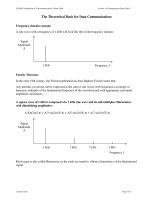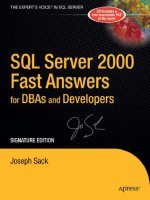Tài liệu Impossible Certainty - Cost Risk Analysis for Air Force Systems ppt
Bạn đang xem bản rút gọn của tài liệu. Xem và tải ngay bản đầy đủ của tài liệu tại đây (508.96 KB, 194 trang )
THE ARTS
This PDF document was made available
CHILD POLICY
from www.rand.org as a public service of
CIVIL JUSTICE
the RAND Corporation.
EDUCATION
ENERGY AND ENVIRONMENT
Jump down to document6
HEALTH AND HEALTH CARE
INTERNATIONAL AFFAIRS
NATIONAL SECURITY
POPULATION AND AGING
PUBLIC SAFETY
SCIENCE AND TECHNOLOGY
SUBSTANCE ABUSE
TERRORISM AND
HOMELAND SECURITY
TRANSPORTATION AND
INFRASTRUCTURE
WORKFORCE AND WORKPLACE
The RAND Corporation is a nonprofit
research organization providing
objective analysis and effective
solutions that address the challenges
facing the public and private sectors
around the world.
Support RAND
Purchase this document
Browse Books & Publications
Make a charitable contribution
For More Information
Visit RAND at www.rand.org
Explore RAND Project AIR FORCE
View document details
Limited Electronic Distribution Rights
This document and trademark(s) contained herein are protected by law
as indicated in a notice appearing later in this work. This electronic
representation of RAND intellectual property is provided for noncommercial use only. Permission is required from RAND to reproduce, or
reuse in another form, any of our research documents.
This product is part of the RAND Corporation monograph series.
RAND monographs present major research findings that address the
challenges facing the public and private sectors. All RAND monographs undergo rigorous peer review to ensure high standards for
research quality and objectivity.
Impossible
Certainty
Cost Risk Analysis for Air Force Systems
Mark V. Arena, Obaid Younossi, Lionel A. Galway, Bernard Fox,
John C. Graser, Jerry M. Sollinger, Felicia Wu, Carolyn Wong
Prepared for the United States Air Force
Approved for public release;
distribution unlimited
The research described in this report was sponsored by the United States
Air Force under Contract F49642-01-C-0003. Further information may
be obtained from the Strategic Planning Division, Directorate of Plans,
Hq USAF.
Library of Congress Cataloging-in-Publication Data
Impossible certainty : cost risk analysis for Air Force systems / Mark V. Arena ... [et al.].
p. cm.
Includes bibliographical references.
“MG-415.”
ISBN 0-8330-3863-X (pbk. : alk. paper)
1. United States. Air Force—Appropriations and expenditures. 2. United States.
Air Force—Costs. 3. United States. Air Force—Cost control. I. Arena, Mark V.
UG633.2.I6 2006
358.4'1622—dc22
2005028332
The RAND Corporation is a nonprofit research organization providing
objective analysis and effective solutions that address the challenges
facing the public and private sectors around the world. R AND’s
publications do not necessarily reflect the opinions of its research clients
and sponsors.
R® is a registered trademark.
Cover design by Stephen Bloodsworth
© Copyright 2006 RAND Corporation
All rights reserved. No part of this book may be reproduced in any
form by any electronic or mechanical means (including photocopying,
recording, or information storage and retrieval) without permission in
writing from RAND.
Published 2006 by the RAND Corporation
1776 Main Street, P.O. Box 2138, Santa Monica, CA 90407-2138
1200 South Hayes Street, Arlington, VA 22202-5050
4570 Fifth Avenue, Suite 600, Pittsburgh, PA 15213
RAND URL: />To order RAND documents or to obtain additional information, contact
Distribution Services: Telephone: (310) 451-7002;
Fax: (310) 451-6915; Email:
Preface
This report is one of a series from a RAND Project AIR FORCE
project, “The Cost of Future Military Aircraft: Historical Cost Estimating Relationships and Cost Reduction Initiatives.” The purpose
of the project is to improve the tools used to estimate the costs of
future weapon systems. It focuses on how recent technical, management, and government policy changes affect cost. This report examines cost estimating risk analysis methods and recommends a policy
prescription.
The project was conducted within the RAND Project AIR
FORCE Resource Management Program. The research is sponsored
by the Principal Deputy, Office of the Assistant Secretary of the Air
Force (Acquisition), Lt Gen John D.W. Corley. The project technical
monitor is Jay Jordan, Technical Director of the Air Force Cost
Analysis Agency.
This report should interest government cost analysts, the military acquisition communities, and those concerned with current and
future acquisition policies.
Other RAND Project AIR FORCE reports that address military
aircraft cost estimating issues include the following:
• In An Overview of Acquisition Reform Cost Savings Estimates,
MR-1329-AF, 2001, Mark Lorell and John C. Graser use relevant literature and interviews to determine whether estimates of
the efficacy of acquisition reform measures are robust enough to
be of predictive value.
iii
iv
Impossible Certainty: Cost Risk Analysis for Air Force Systems
• In Military Airframe Acquisition Costs: The Effects of Lean
Manufacturing, MR-1325-AF, 2001, Cynthia R. Cook and John
C. Graser examine the package of new tools and techniques
known as “lean production” to determine whether it would
enable aircraft manufacturers to produce new weapon systems at
costs below those predicted by historical cost estimating models.
• In Military Airframe Costs: The Effects of Advanced Materials and
Manufacturing Processes, MR-1370-AF, 2001, Obaid Younossi,
Michael Kennedy, and John C. Graser examine cost estimating
methodologies and focus on military airframe materials and
manufacturing processes. This report provides cost estimators
with factors useful in adjusting and creating estimates based on
parametric cost estimating methods.
• In Military Jet Engine Acquisition: Technology Basics and CostEstimating Methodology, MR-1596-AF, 2002, Obaid Younossi,
Mark V. Arena, Richard M. Moore, Mark Lorell, Joanna
Mason, and John C. Graser introduce a new methodology for
estimating military jet engine costs and discuss the technical
parameters that derive the engine development schedule, development cost, and production costs. They also present quantitative analysis of historical data on engine development schedule
and cost.
• In Test and Evaluation Trends and Costs in Aircraft and Guided
Weapons, MG-109-AF, 2004, Bernard Fox, Michael Boito, John
C. Graser, and Obaid Younossi examine the effects of changes in
the test and evaluation (T&E) process used to evaluate military
aircraft and air-launched guided weapons during their development programs. They also provide relationships for developing
estimates of T&E costs for future programs.
• In Software Cost Estimation and Sizing Methods: Issues and
Guidelines, MG-269-AF, 2005, Shari Lawrence Pfleeger, Felicia
Wu, and Rosalind Lewis recommend an approach to improve
the utility of the software cost estimates by exposing uncertainty
and reducing risks associated with the developing the estimates.
• In Lessons Learned from the F/A-22 and F/A-18 E/F Development
Programs, MG-276-AF, 2005, Obaid Younossi, David E. Stem,
Preface
v
Mark A. Lorell, and Frances M. Lussier evaluate historical cost,
schedule, and technical information from the development of
the F/A-22 and F/A-18 E/F programs to derive lessons for the
Air Force and other services to improve the acquisition of future
systems.
RAND Project AIR FORCE
RAND Project AIR FORCE (PAF), a division of the RAND
Corporation, is the U.S. Air Force’s federally funded research and
development center for studies and analyses. PAF provides the Air
Force with independent analyses of policy alternatives affecting the
development, employment, combat readiness, and support of current
and future aerospace forces. Research is conducted in four programs:
Aerospace Force Development; Manpower, Personnel, and Training;
Resource Management; and Strategy and Doctrine.
Additional information about PAF is available on our Web site
at />
Contents
Preface ...................................................................... iii
Figures ...................................................................... xi
Tables ...................................................................... xiii
Boxes........................................................................xv
Summary ................................................................. xvii
Acknowledgments........................................................xxiii
Abbreviations .............................................................xxv
CHAPTER ONE
Introduction.................................................................1
Overview of General Risk Analysis ..........................................1
History of General Risk Analysis ............................................2
The Components of Risk Analysis ...........................................3
Risk Assessment ...........................................................4
Risk Management .........................................................4
Risk Communication .....................................................5
Uncertainty and Risk in Cost Estimation ...................................6
History of Cost Risk Analysis ................................................7
Obstacles to Use of Cost Risk Analysis .................................... 13
Purpose of This Study ..................................................... 15
How We Went About Conducting This Study ........................... 16
Task 1: An Analysis of Weapon System Cost Growth.................. 16
Task 2: A Review of Risk/Uncertainty Assessment Methodologies .... 16
Task 3: The Cognitive Psychology of Risk Assessment ................. 17
Task 4: Risk Management for a Collection of Programs ............... 17
vii
viii
Impossible Certainty: Cost Risk Analysis for Air Force Systems
Task 5: Communication of Cost Risk to Decisionmakers ............. 17
Task 6: Considerations for a Cost Risk Policy .......................... 18
How This Report Is Organized ............................................ 18
CHAPTER TWO
History of Cost Growth .................................................. 19
Cost Growth Data ......................................................... 19
Analytic Approach ......................................................... 22
Sample Selection ........................................................ 22
Cost Growth Metric .................................................... 23
Normalization........................................................... 23
Cost Growth Analysis ...................................................... 25
Segmented CGF Results ................................................ 25
Correlations ............................................................. 31
Observations ............................................................... 32
CHAPTER THREE
A Review of General Risk Methods...................................... 35
Risk Assessment Methods.................................................. 35
Benefit-Cost Analysis ................................................... 36
Expert Judgment ........................................................ 36
Fault Tree Analysis...................................................... 37
Focus Groups/One-on-One Interviews ................................. 37
Root Cause Analysis/Failure Modes and Effects Analysis .............. 37
Behavior Modeling...................................................... 38
Data-Based Methods .................................................... 39
Integrated Assessment................................................... 39
Observations ............................................................... 40
CHAPTER FOUR
Risk Analysis in Cost Estimation ........................................ 41
Review of Cost Risk Methodologies ....................................... 42
Deterministic Cost Risk Methodologies ................................ 44
Probabilistic Cost Risk Methodologies ................................. 50
Characterizing the Methodologies ......................................... 63
Current State of Practice ................................................... 65
Contents
ix
Implications for Cost Risk Policy .......................................... 69
Overall Observations.................................................... 69
Key Elements of an Air Force Cost Risk Policy ........................ 69
CHAPTER FIVE
Decisionmaker Perspectives on Cost Risk Analysis .................... 71
What Are Decisionmakers Looking For? .................................. 71
Results of Interviews with Key Acquisition Decisionmakers .............. 72
Question 1 .............................................................. 72
Question 2 .............................................................. 74
Question 3 .............................................................. 75
Question 4 .............................................................. 76
Question 5 .............................................................. 77
Comparison Between Senior Acquisition Officials and Cost Risk
Analysis Communities ............................................... 79
CHAPTER SIX
Communicating Cost Risk to the Decisionmakers ..................... 81
What Is Risk Communication? ............................................ 81
Communicating Cost Risk and Uncertainty .............................. 83
A Recommended Approach for Communicating Cost Risk .............. 84
Summary ................................................................... 86
CHAPTER SEVEN
Setting a Cost Risk Analysis Policy ...................................... 87
Considerations in Generating a Cost Risk Policy.......................... 87
What Assessment Method to Use? ...................................... 88
Which Risks to Consider? .............................................. 92
How to Communicate Findings? ....................................... 96
Additional Issues ........................................................ 96
Policy Considerations ...................................................... 97
APPENDIX
A. Programs Included in the Cost Growth Analysis ................. 101
B. List of Those Interviewed for the Project .......................... 105
C. Cost Risk Questions................................................. 109
x
D.
E.
F.
G.
Impossible Certainty: Cost Risk Analysis for Air Force Systems
Cognitive Psychology and Cost Risk Assessment ................. 115
Risk Management for a Collection of Programs .................. 135
The Scenario-Based Method Applied to Three-Point Range ..... 147
Designation of Selected Acquisition Report Milestones .......... 155
Bibliography ............................................................. 157
Figures
S.1. Distribution of Total Cost Growth from Milestone II,
Adjusted for Production Quantity Changes ...................... xix
1.1. Cost Risk as a Probability Distribution ........................... 10
2.1. Distribution of Total Cost Growth from Milestone II,
Adjusted for Production Quantity Changes ...................... 28
4.1. Illustration of Historical Analogy ................................. 45
4.2. Total Cost Distribution from Monte Carlo Simulation .......... 61
6.1. Example of a Three-Point Range Estimate ....................... 85
7.1. Choosing Between Cost Risk Assessment Methods .............. 91
E.1. Cost Probability Distributions for a Hypothetical Portfolio
of Programs ...................................................... 137
F.1. SBM Applied to a Three-Point Communications Approach .... 149
xi
Tables
2.1. CGF Summary Statistics by Funding Categories from
Milestone II ....................................................... 29
2.2. CGF Summary Statistics by Funding Categories from
Milestone III ...................................................... 29
2.3. A Comparison of the CGF Means for Milestone II Between
This Study and the 1993 RAND Study .......................... 30
2.4. CGF for Adjusted Total Growth, by Milestone .................. 31
2.5. CGF for Unadjusted Total Growth, by Milestone ............... 31
4.1. Sensitivity Analysis for Manufacturing Costs ..................... 49
4.2. Nominal Expert Distributions on Weight and Speed ............ 60
4.3. Summary of Method Characteristics ............................. 64
A.1. Programs Included in the Analysis, by Milestone ............... 102
D.1. Methods of Cost Risk Assessment and Associated Potential
Biases ............................................................. 129
E.1. Comparison of Individual and Pooled Reserves for the
Hypothetical Portfolio ........................................... 138
xiii
Boxes
4.1.
4.2.
4.3.
4.4.
4.5.
4.6.
4.7.
Illustrative Example: Overview ................................... 44
Illustrative Example: Historical Method Application............. 45
Illustrative Example: Cost Factor Application .................... 48
Illustrative Example: Sensitivity Analysis Application ............ 49
Illustrative Example: Propagation of Errors Application ......... 52
Illustrative Example: Expert Opinion Application ............... 53
Illustrative Example: Error of Estimating Method
Application........................................................ 55
4.8. Illustrative Example: Monte Carlo Application................... 60
xv
Summary
Background
The Department of Defense (DoD) forecasts its expenditures several
years into the future. An important element of that forecast is the
estimated cost of weapon systems, which typically take many years to
acquire and remain in operation for a long time. To make those estimates, the Office of the Secretary of Defense (OSD) and the military
departments use cost analysis, a discipline that attempts to forecast
the ultimate cost of a weapon system far in advance of actual expenditures. But estimates are just that—estimates—not certain predictions
of future costs. An analyst does not have perfect knowledge about
technology, economic conditions, and other future events. Thus, a
cost estimate carries with it an uncertainty and, thereby, a risk that
actual costs might be higher or lower than originally anticipated. 1
Uncertainty occurs for a number of reasons. For example, critical technical information or parameters might be unknown, poorly
understood, poorly defined, or undefined when an estimate is prepared. This situation is particularly true early in a program’s acquisition cycle. For example, parametric estimating methodologies for
aircraft cost use characteristic factors (weight, lines of code, etc.) to
forecast cost. These values might be hard to define accurately or
might evolve due to changing requirements over the program’s life.
____________
1
In this report, we define uncertainty as the indefiniteness in outcome—good or bad—
whereas risk refers to the possibility of loss or injury, someone or something that creates or
suggests a hazard, or the probability or likelihood of an adverse effect or event occurring.
xvii
xviii
Impossible Certainty: Cost Risk Analysis for Air Force Systems
Thus, the estimator must make some judgments about which values
to use as a basis for estimate. Even if the actual values of these
parameters could be known ahead of time, the parametric estimating
method still cannot forecast cost with 100 percent certainty. Parametric forecasts contain error because parametric relationships only
approximate actual cost behavior.
Uncertainty can also occur when a program uses new technologies or approaches. This situation is difficult for estimators because
they have no historical analogy from which to make an estimate.
Thus, an estimator must develop a new estimating approach based on
limited experience or extrapolate using existing methods. New technologies and approaches also have the potential for failure, or they
can encounter development difficulties leading to additional work or
alternative solutions. Unfortunately, it is difficult to identify which
technologies will have such problems and the resultant cost effect.
Another class of uncertainty relates to economic conditions.
Some pertain specifically to a supplier or producer. For example,
worker wage rates generally increase over the course of a program.
However, it is difficult to forecast the magnitude of these increases
because they are tied to national and local economic conditions, labor
relations, and overall inflation. Another producer issue related to cost
uncertainty corresponds to indirect costs. These costs, such as overhead, depend heavily on the business base of the firm. Thus, how
successful the firm is in winning and holding other work not necessarily related to a program will influence indirect rates of that program.
Yet another class of uncertainty involves unusual or rare events.
Examples of these types of risks are fire, earthquakes, and labor
actions. Although uncommon, these types of events do occur and can
have significant cost consequences on a program.
Why Is It Important to Consider Cost Uncertainty?
By and large, OSD and the military departments have historically
underestimated and underfunded the cost of buying new weapon sys-
Summary
xix
tems. Figure S.1 shows the cost growth factor (CGF) for programs
dealing with systems that were similar in complexity to those procured by the Air Force (e.g., aircraft, missiles, electronics upgrades)
and were either finished or nearly finished—that is, greater than 90
percent of production was completed.2 The CGF metric is the ratio
of the final cost to the estimated costs using Milestone II estimates. A
CGF of less than 1.0 indicates that the initial program budget was
higher than the final cost—an underrun. When the CGF exceeds 1.0,
the final costs were higher than the initial budget—an overrun.
Figure S.1
Distribution of Total Cost Growth from Milestone II, Adjusted for
Production Quantity Changes
16
14
Frequency
12
10
8
6
4
2
0
0.75–
1.00
1.00–
1.25
1.25–
1.50
1.50–
1.75
1.75–
2.00
2.00–
2.25
2.25–
2.50
CGF range
NOTE: Includes research and development, as well as production funding.
RAND MG415-S.1
____________
2
The data are drawn from Selected Acquisition Reports. They have been modified to
account for inflation and changes in the number of systems produced.
xx
Impossible Certainty: Cost Risk Analysis for Air Force Systems
Figure S.1 indicates both a systematic bias toward underestimating the costs and a substantial uncertainty in estimating the final
cost of a weapon system. Our further analysis of the cost growth data
indicates that the average adjusted total cost growth for a completed
program was 46 percent from Milestone II and 16 percent from
Milestone III. The bias toward cost growth does not disappear until
about three-quarters of the way through production. Chapter Two of
this report explores the cost growth in more detail.
Focus of This Project
In light of such cost growth and variability, senior leaders in the Air
Force want to generate better cost estimates—that is, ones that provide decisionmakers with a better sense of the risk involved in the cost
estimates they receive. To that end, the Air Force Cost Analysis
Agency and the Air Force cost analysis community want to formulate
and implement a cost uncertainty analysis policy. They asked RAND
Project AIR FORCE to help. Since formulating a practical cost risk
analysis policy involves more than selecting a methodology, RAND
considered many issues relevant to its formulation. RAND conducted
research that explored and reviewed various risk assessment methodologies that could be applied to cost estimating for major acquisition
programs. RAND explored how these risk methods and policies relate
to a total portfolio of programs. The research also explored how risk
information can be communicated clearly to senior decisionmakers.
This research was done through literature reviews; discussions with
policymakers, cost estimators, and other researchers; and original
research and analysis of historical cost data.
Policy Considerations
Cost uncertainty analysis is an important aspect of cost estimating
and benefits decisionmaking. It helps decisionmakers understand not
only the potential funding exposure but also the nature of risks for a
Summary
xxi
particular program. The process can also aid in the development of
more-realistic cost estimates by critically evaluating program assumptions and identifying technical issues. While we do not measure or
quantify the benefits in terms of effectiveness in improving decisions
and cost estimating, it is axiomatic that additional information (when
correctly gathered and presented well) is of value to the decisionmaker.
A poorly done uncertainty analysis has the potential to misinform, however. Therefore, any cost uncertainty analyses should be
comprehensive and based on sound analysis and data. It should consider a broad range of potential risks to a program, not just those that
are currently the main concerns of the program office or contractor.
Furthermore, the analysis should be rigorous and follow accepted
practice for the particular method or methods employed. To the
extent possible, independent technical evaluation should aid in the
assessment of program cost assumptions.
The Air Force should consider several issues in formulating a
cost uncertainty analysis policy:
• A single uncertainty analysis method should not be stipulated for all circumstances and programs. It is not practical to
stipulate one specific cost uncertainty analysis methodology in
all cases. Rather, the policy should offer the flexibility to use different assessment methods. Moreover, a combination of methods might be desirable and more effective in communicating
risks to decisionmakers. (See pp. 35–70.)
• A uniform communications format should be used. A consistent display of information to senior decisionmakers can be
helpful in explaining results and also allows for comparisons
among programs. RAND suggests a basic three-point format
(low, base, and high values) as a minimum basis for displaying
risk analysis. The three points are used to show the decisionmaker a reasonable range of possible outcomes. The advantage
of such an approach is that it allows for a consistent format
across a variety of risk analysis methods. (See pp. 81–86.)
xxii
Impossible Certainty: Cost Risk Analysis for Air Force Systems
• A record of cost estimate accuracy should be tracked and updated periodically. To ensure that both the cost estimating and
uncertainty analysis processes provide accurate information,
estimates and assessment records should be kept and compared
with final costs when those data become available. Such a process will enable organizations to identify areas where they may
have difficulty estimating and sources of risk that were not adequately examined. A retrospective analysis of a program at completion would be one way to formalize the process, and the
results could recommend improvements to the risk analysis
process. In addition, a comparison with a previous estimate for
the same system would be useful in documenting why cost estimates have changed since a previous milestone or other major
decision point. It should be part of a continuous improvement
effort for cost estimating. (See pp. 71–80.)
• Risk reserves should be an accepted acquisition and funding
practice. Any policy needs to provide for a risk reserve.3
Reserves should be used to fund costs that arise from unforeseen
circumstances. However, under the current DoD and congressional acquisition and budgeting process, this recommendation
will be difficult to implement. Establishing an identified risk
reserve involves cultural changes in the approach to risk, not
regulatory or legislative changes. Today, the only viable
approach to including a reserve is burying it in the elements of
the estimate. Although pragmatic, this approach has drawbacks.
The burying approach will make it difficult to do retrospective
analysis of whether the appropriate level of reserve was set (or
the uncertainty analysis was accurate). This approach also will
make it difficult to move reserves, when needed, between elements of a large program. (See pp. 71–80, 135–145.)
____________
3
Nowhere in this report do we address an approach to setting a risk reserve. For example,
some have argued for a uniform 80 percent confidence level, while others have developed
analytic methods (Anderson, 2003). Ultimately, we feel that the reserve needs to be set by
the decisionmaker responsible for setting funding levels informed by the uncertainty assessment. The nature of the program will determine the level of the reserve, and that level will
vary across programs.
Acknowledgments
First, we would like to thank Lt Gen John Corley, SAF/AQ, and
Blaise Durante, SAF/AQX, for sponsoring this project. Also, we
thank Richard Hartley (director) and Jay Jordan (technical director)
of the Air Force Cost Analysis Agency for their help, vision, and
guidance as the study unfolded.
Many people throughout the cost estimating and acquisition
community deserve our gratitude for the generous sharing of their
time, insight, and knowledge of the cost-risk analysis process. They
are too numerous to thank individually, but we would like to at least
recognize their organizations. The governmental organizations we
met with were as follows:
•
•
•
•
•
•
•
•
•
•
•
Air Force Aeronautical Systems Center, Cost Group
Air Force Cost Analysis Agency
Air Force Space and Missile Command, Cost Group
Assistant Secretary of the Army for Cost and Economic Analysis
Intelligence Community Cost Analysis Improvement Group
National Aeronautics and Space Administration (NASA) Headquarters Cost Analysis Division
NASA Jet Propulsion Laboratory
National Reconnaissance Organization
Naval Air Systems Command, Cost Department, AIR-4.2
Naval Cost Analysis Division
Missile Defense Agency
xxiii









